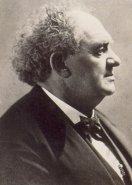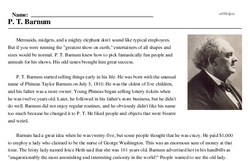P. T. Barnum
Mermaids, midgets, and a mighty elephant don't sound like typical employees. But if you were running the "greatest show on earth," entertainers of all shapes and sizes would be normal. P. T. Barnum knew how to pick fantastically fun people and animals for his shows. His odd tastes brought him great success.
P. T. Barnum started selling things early in his life. He was born with the unusual name of Phineas Taylor Barnum on July 5, 1810. He was the oldest of five children, and his father was a store owner. Young Phineas began selling lottery tickets when he was twelve years old. Later, he followed in his father's store business, but he didn't do well. Barnum did not enjoy regular routines, and he obviously didn't like his name too much because he changed it to P. T. He liked people and objects that were bizarre and weird.
Barnum had a great idea when he was twenty-five, but some people thought that he was crazy. He paid $1,000 to employ a lady who claimed to be the nurse of George Washington. This was an enormous sum of money at that time. The feisty lady named Joice Heth said that she was 161 years old. Barnum advertised her in his handbills as "unquestionably the most astonishing and interesting curiosity in the world!" People wanted to see the old lady. Barnum made about $1,500 a week with his peculiar employee.
Joice Heth was not a typical star, either. She was blind. She was almost totally paralyzed. And she wasn't nearly as old as she said she was. When she died in 1839, people figured out that she was only 80 years old. P. T. Barnum was sorry to lose his main attraction, but he knew he was on the right track and was determined to find more "freaks" for his tours.
In 1841, Barnum bought an old museum on Broadway in New York. He collected 500,000 "curiosities" from all over the world. He had one exhibit called the Feejee Mermaid. The "mermaid" was purchased from a Boston seaman. It was supposedly caught off of the Feejee (or Fiji) Islands in the South Pacific. The mermaid had a mummified body. Half of its body was a mammal. The other half was a fish.




